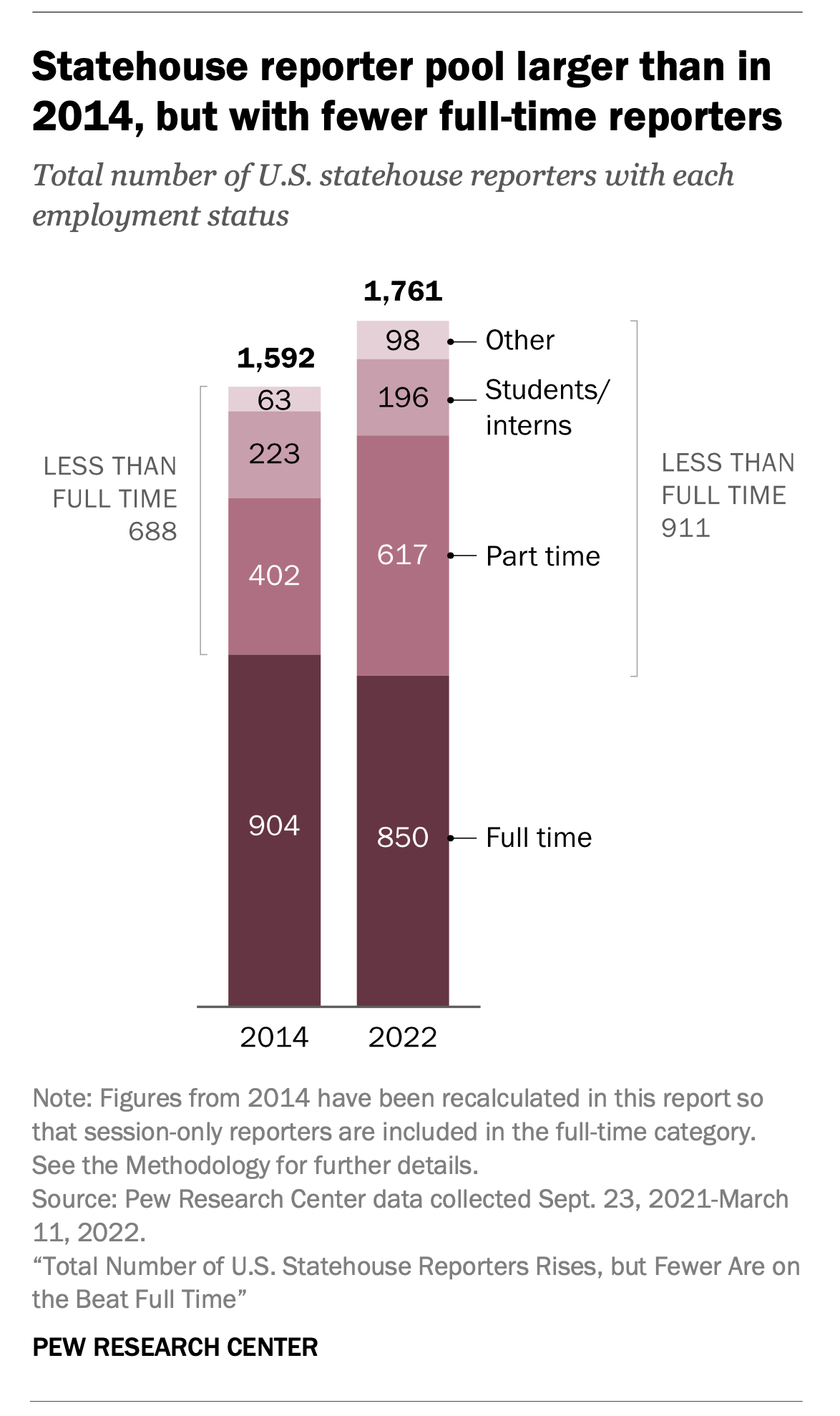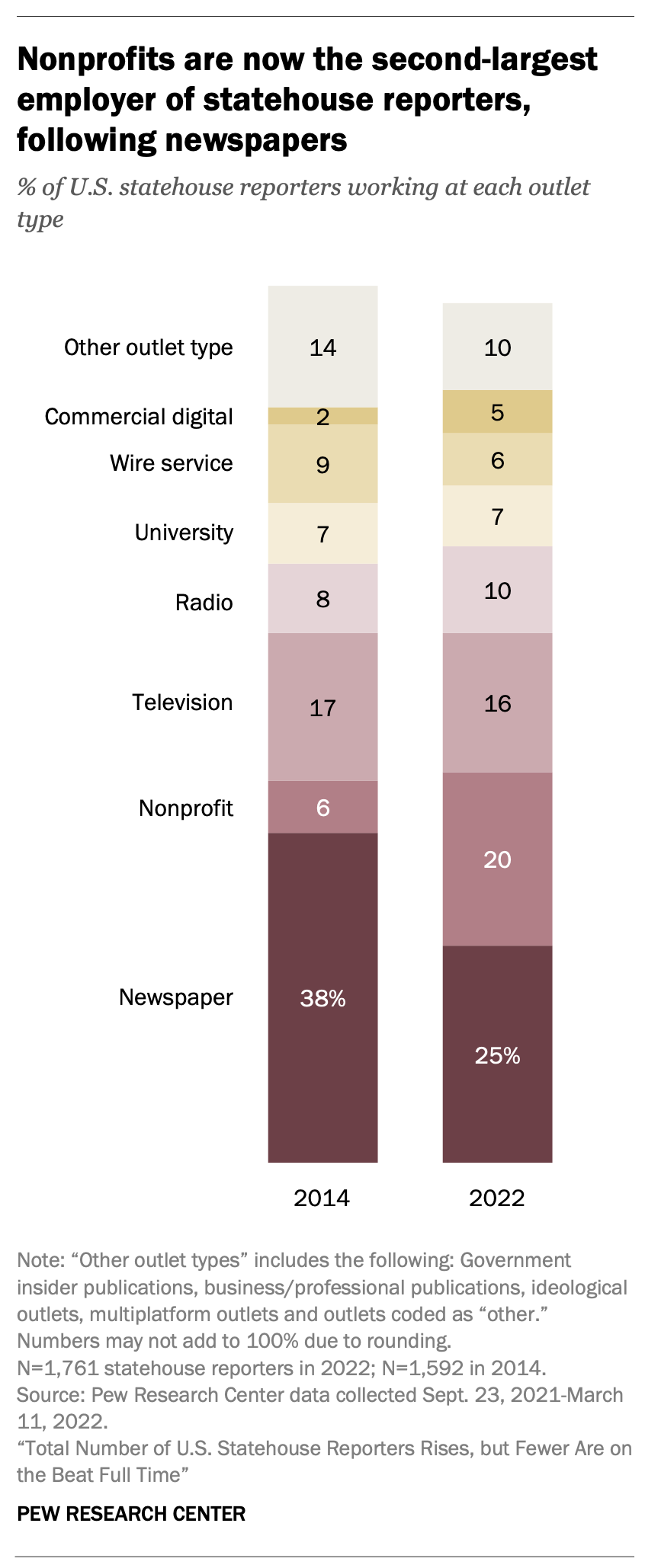A staple of the decline-of-newspapers narrative has long been that statehouse coverage became a shadow of itself — once buzzing pressrooms nearly emptied, accountability coverage gutted. (And who merits that sort of coverage more than state legislators?)
However, an ambitious new Pew Research Center census released Tuesday finds an uptick in the number of reporters since a previous report in 2014 — 1,761 now compared to 1,592 then.
That good news comes with important asterisks. Fewer full-time and more part-time journalists make up the mix. Newspapers’ commitment to the beat continues to decline. Television and radio have remained about the same. Most of the growth is coming from nonprofit digital startups and the work of college students.
Some relevant numbers:
- Full-time reporters declined from 904 to 850, part-time reporters increased from 688 to 911.
- The surging nonprofit sector is up from just 6% of the total in 2014 to 20% now. About half of those journalists are full-time, and nonprofits make up the largest sector in 10 states.
- Commercial digital outlets have also grown from 2% to 5% of the total and are the largest sector in two states, the second-largest in five others.
- Decline is concentrated in the newspaper industry (though still the largest sector overall), falling from 604 to 448 positions.
- Wire service coverage has also declined from 139 to 107 positions. The current number is being bolstered by a contingent from Report for America, helping The Associated Press keep a longtime pledge of covering all 50 state capitals.
A curveball for the study conducted from last fall through this spring is that it coincided with the COVID-19 pandemic. Some but not all state capital business was conducted virtually and often livestreamed in 2020 and 2021, reducing the need for on-the-scene reporters.
Pew supplemented the study with a group of 24 interviews, mainly of experienced statehouse reporters. They see the same cross-currents the survey suggests.
Sarah Gamard, formerly of The News Journal of Wilmington, Delaware, said that statehouse reporters “often have other jobs or they often have other obligations, myself included. … In a perfect world, there would be one of me sitting in the committee meetings and listening to every single debate just looking for nuggets.”
Marianne Goodland, chief statehouse reporter at Colorado Politics, has watched an extended decrease in newspaper reporters. When she started there nearly 25 years ago, she said, “you had all these newspapers, and all of them daily print publications. We probably had nine or 10 newspapers that had reporters who were there every day. Almost all of those papers don’t have people at the Capitol anymore.”
On the other hand, the newer sector brings both reach and diversity. The nonprofit Spotlight PA shares its content across 79 outlets (nonprofit and for-profit) and could be a replicable model for other states.
Janis Ware, publisher of the African American-focused Atlanta Voice, added statehouse coverage relatively recently. “Sometimes I think we have to recognize that what is done at the state (level) controls everything,” she said.
A separate portion of the study sought to quantify coverage of Native American tribal governments. Pew Research found 134 reporters at 44 different outlets. Unfortunately, so many of those are owned or supported by tribal governments that independent investigative or accountability coverage is often compromised.
I chatted with Amy Mitchell, who directs Pew’s journalism research and was a co-author of the report, for additional commentary.
Improvement in the overall staffing level from the 2014 survey is noteworthy, she said. At the same time, fewer full-timers and the COVID-19 factor have two troubling effects: “This is time-consuming work,” not so well-suited to part-time attention, Mitchell told me, and “relationship building with sources” could also be a casualty.
As for how the picture will change post-COVID, she added, that’s hard to say this soon, even in the short run. More video and better access to it would be a plus for those who want to follow legislative sessions in progress or a particular issue.
The survey provoked a couple of more thoughts for me. I wonder whether both the numbers and the changing mix of newspapers and digital nonprofits may be representative of industry trends in cities and states all over.
In trying to track the conflict between the University of North Carolina and Nikole Hannah-Jones, I have noticed that while The News & Observer in Raleigh and The Charlotte Observer are diminished, TV, public radio and any number of independents and digital startups are on the rise. An ambitious one, The Assembly, just 18 months old, boasts two former News & Observer editors as advisers or contributors.
My tenure in Florida is long enough that I remember the bustling statehouse reporting scene of yore with a dozen bureaus competing for scoops. The Tampa Bay Times and Miami Herald put aside bragging rights and combined their Tallahassee operations more than a decade ago to good effect. But their pooled bureau has since had its own contractions.
As with much else in the industry, the good old days of a more robust newspaper presence in the state capitals are not coming back. The Pew report does provide encouragement, though, that nature may indeed abhor a vacuum in this crucial area of local reporting as others rush in.









